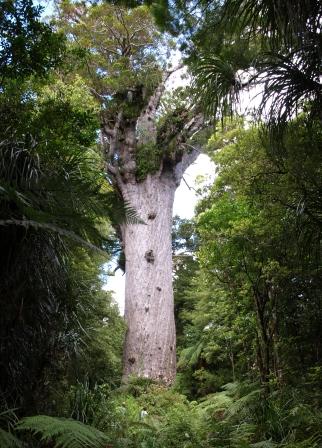Now that's a big tree!

VulcanSpirit
Richard & Alison Brunstrom
Tue 19 Feb 2013 10:11
|
Here it is:
 It may not look like much, until you spot Alison's
head in the undergroth at the bottom of the trunk. This is Tane Mahuta, the Lord
of the Forest, the biggest kauri tree in NZ. NZ kauri are Agathis
australis (australis means 'southern' in Latin) to distinguish them from
the other Agathis species which live in Australia and SE Asia. It is a NZ
endemic. They are closely related to the monkey puzzle tree familiar in UK
gardens (it actually comes from Chile) and is yet another example of things
that evolved in Gondwana more than 70 million years ago. Tane Mahuta is around
2000 years old and has a total wood volume of over 500 cubic metes, making this
the third biggest tree species in the world after the North American redwoods
Sequoia and Sequoiadendron. Very much bigger kauris are known
to have been cut down, and Tane Mahuta is still actively growing so perhaps in
another thousand years he'll rival the redwoods.
Kauri forests once covered a vast tract of NZ's
North Island, but tragically they were almost all cut down in a frenzy during
the 1800s - the unique growing style with the huge straight branchless trunk
providing outstanding knot-free timber. Only tiny fragments remain.
Kauri start life looking completely different.
Here's a baby, with a conical crown:
 And here are some young adult trees, before
the huge trunk and giant splayed crown develop:
 These are still tiddlers, but for scale note
the people passing below.
The remaining kauri forests are reserves, but
the kauri are not out of the woods yet (couldn't resist it). Worryingly, mature
kauri are dying of 'kauri die-back disease', a fungal infection. Kauri roots are
shallow and delicate. It is now realised that humans trampling round the trees
can wound the roots (they evolved in the total absence of heavy footed animals)
allowing fungus to enter - and human feet are transporting fungal spores from
one forest to another. So now access to kauri reserves requires footwear to be
washed on entry and exit, and you can only approach the trees via
boardwalks and prepared paths.
Kauri are a national treasure, and the few
remaining forest fragments truly astounding places. I hope they
survive.
|